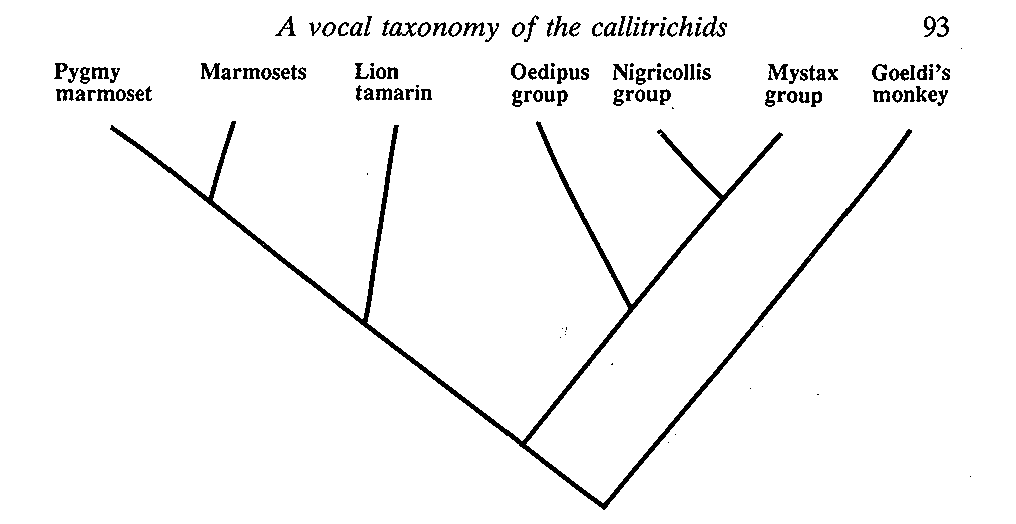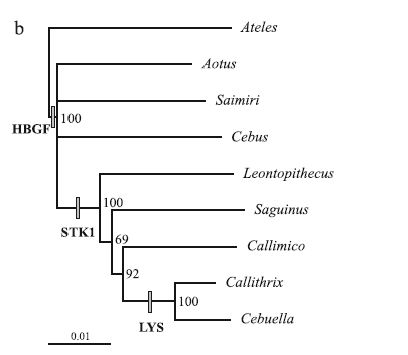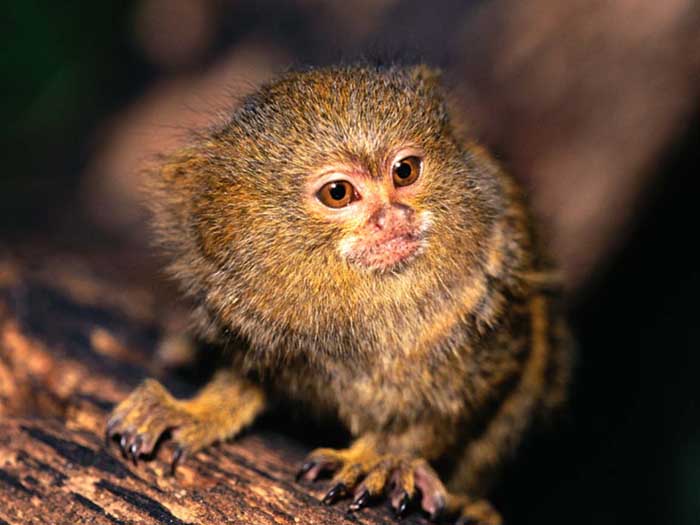Classification
Domain:
Eukarya
Kingdom: Animalia
Phylum: Chordata
Class: Mammalia
Order: Primates
Family: Callitrichidae
Genus: Cebuella/ Callithrix
Species: Pygmaea
Callithrix pygmaea, also known as the pygmy marmoset in
English, has been classified according to the figure above,
(Redlist, 2008).
Eukarya
Pygmy marmoset has been classified in the domain group
Eukarya because of the monkey’s cells. The pygmy marmoset like most
animals is composed of eukaryotic cells. These cells are different
from prokaryotic cells in that they are larger, contain a nucleus,
and have organelles through endosymbiosis and evolution, (Kandler,
2002).
Animalia
The kingdom Animalia is made up of organisms that are
multicellular and heterotrophic (rely on energy from other
organisms). These organisms are unlike the kingdom plantae in that
they lack the strong cells walls and autotrophic mechanisms (ability
to make their own food). Most organisms within the kingdom Animalia
can also be classified by the presence of true tissues except for
sponges, (ADW: Animalia, 2001) .
Chordata
Pygmy Marmosets fall into the phylum Chordata. Some
features that define Chordata include pharyngeal slits, dorsal nerve
cord, notochord, and post-anal tail. Keep in mind that these
features must be present at some point in the organism’s life in
order to be classified in the phylum Chordata. Other important
features include, bilateral symmetry, three germ layers, a complete
digestive system, and a closed circulatory system, (ADW: Chordata,
2001).
Mammalia
The familiar class Mammalia also includes the pygmy
marmoset and is defined by the presence of mammary glands, a
vertebral column, and hair at some point in their life. Organisms in
Mammalia are generally warm-blooded (endothermic) yet rely on other
environmental sources of heat to keep warm, (EOL Mammalia, 2013).
Primates
The category primate is defined by certain physical
characteristics that set it apart from other groups of mammals.
Familar animals in this category include the
ring tailed lemur,
gorilla,
chimpanzee and, the
orangutan.
First looking at the brain of a primate it is much larger than other
mammals and has a unique groove that separates the first and second
visual regions on the left and right side of the brain. Looking down
at primate’s extremities we can see that primate have flat nails
instead of the usual claws or hooves. In addition, another defining
feature is the presence of opposable thumbs in some primates,
(Groves and Napier, 2013).
Callitrichinae
The family of Callitrichinae is made up of the primates’
marmosets and tamarins. These two groups of primates are the
smallest primates in the world making it a perfect family for the
pygmy marmoset! Those in the family Callitrichinae lack the
opposable thumbs that most primates have and have sharp claws
instead of flat nails that they use to dig
into trees. Another defining feature of the Callitrichinae is in how
they reproduce and parent. Tamarins and marmosets depend on the male
for early infant care by carrying the young on their back and only
handing the infant over to the mother for feeding, (ADW:
Callitrichinae, 2013)For more information on reproductive strategies
on the pygmy marmoset visit the reproduction page!
Cebuella/ Callithrix:
The pygmy marmoset
has been put into the category Cebuella and Callithrix because it is
still uncertain as to which genus it belongs in. Therefore, the name
Cebuella Pgymaea and Callithrix Pygmaea are both referring to the
pygmy marmoset. However, new evidence has suggested that because of
a determining gene sequence that the pygmy marmoset should be placed
in the genus Callithrix, (C. M. L. Barroso et al. 1997).
Therefore, the characteristics that define Callithrix are gum
feeding and insect feeding organisms that are considered “true
marmosets”, (A. Rylands et al., 1993).
Pygmaea
Pygmaea is the species name for the pygmy marmoset and is
completely unique to this animal. More information on the species
can be found in adaptation,
habitat,
reproduction, interactions, and
quick facts.
Relatedness and
Phylogenies

Figure 1. Hypothesized
relationships of the callitrichids based on vocal characters of long
calls (Rylands, 1993).
This tree is based on the
vocalizations, a morphological characteristic, of the family
Callitrichidae. It shows that the Pygmy marmoset’s closest relative
is the Marmosets. The Oedipus, Nigricollis, and Mystax groups are
more closely related to each other than they are to any other
groups.

Figure 2. “Maximum
likelihood reconstruction based on the concatenated intron
sequences” and “branch lengths represent nucleotide substitutions
per site” (Singer et al., 2003).
This tree is based on
molecular data from gene sequences, specifically intron sequences.
Subunits of DNA called nucleotides were matched from intron
sequences, the portion that is removed during RNA splicing.
Pygmy marmosets belong to
either the genus Callithrix or Cebuella (it is still
being debated). This tree shows that Callithrix and
Cebuella genera are more closely related than to any other
genus.
